
图1 气体间隙开关触发寿命试验研究平台拓扑
Fig.1 Topology of research platform for gas switch trigger lifetime
摘要 气体间隙开关重复触发动作导致其触发腔的机械性能、电气性能降低,在配电网快速控制与保护应用场景中的影响或将更加显著,亟须开展触发腔性能劣化及其寿命预测研究,为此搭建了气体间隙开关触发放电研究平台。研究结果表明,随着触发放电次数的累积,触发腔针电极处内径、喷口直径与内壁表面粗糙度均逐渐增大,喷口内壁出现凹坑、凸起点,针电极处的烧蚀孔洞由“点—线—面”发展,引起气体开关触通过程中的等离子体喷射特性参数(喷射高度、喷射直径、喷射面积)逐渐减小,触通时延、击穿时延均明显增大。在强绝缘、强电负性SF6触发环境中,计及放电烧蚀分解产物的电负性效应,致其喷射等离子体发展过程受到明显抑制,显著制约了触发寿命。选取喷射高度为预测因子,建立基于长短期记忆神经网络(LSTM)的气体开关剩余触发寿命预测模型,模型预测值与试验值间的方均根误差、平均绝对百分比误差分别低至0.063、0.055,剩余触发寿命预测误差在10%以内。研究结果可为气体开关运行稳定性及寿命预测提供参考。
关键词:气体间隙开关 等离子体喷射 重复触发放电 烧蚀累积 寿命预测 配电网
配电网快速控制与保护应用领域对开关设备的技术要求愈加严苛,须满足动作速度快、柔性可控、可靠性高、操作寿命长等要求[1-3],以保障系统拓扑结构改变时(包括正常工作、常规操作和故障动作)的电网安全和稳定运行[4-6]。气体间隙开关结构简单、重复频率高,在配电网多个应用场景中具有明显优势[7-9]。配电网受电端电压降不可避免,对于精密机械加工、半导体、石油化工、通信行业等典型的电压敏感负荷,因低电压造成的损失和危害巨大,每年直接经济损失高达数十亿元。文献[10]提出灵活控制特快速开关(Flexible Control Very Fast Switch, FCVFS)方案,可有效治理配电网电压暂降问题。随着气体开关的重复动作,其触发腔的机械性能、电气性能降低,无法及时、有效地投入备用电源,将影响受电端电压稳定性,甚至引起灾难性事故[11-12]。因此,亟须开展气体开关触发腔性能劣化与寿命预测的研究。
目前,国内外学者主要关注脉冲功率领域场畸变气体开关主电极烧蚀劣化进程,及其寿命预测模型方面的研究。文献[13-15]认为石墨材料与传统金属材料烧蚀进程存在明显差异,在大电流条件下研究了石墨电极烧蚀速率与转移电荷量间的耦合关系,提出了气体开关寿命模型及相应的寿命终止判据。文献[16-17]分析了气体开关的击穿过程,结合电子崩-流注理论提出了气体开关导通时延的数值计算模型。文献[18]认为气体开关时延、抖动均服从正态分布,基于此提出了气体开关失效率随触发放电次数变化的数学模型,建立了气体开关操作寿命的预测模型。上述基于数学模型的方法易受开关放电过程中电-热-力耦合反应的影响,模型构建较为复杂。文献[19]认为气体临界击穿场强是评估气体开关触通能力的关键参数,搭建了气体开关磁流体动力学(Magneto-Hydro Dynamic, MHD)仿真计算模型,研究了气体开关动作时的电弧物性参数特征,提出了气体开关触通性能评估方法,但尚未涉及气体开关触发寿命预测。
近年来,基于数据驱动的电力设备剩余使用寿命预测方法的研究越发成熟,无需考虑复杂的电- 热-力耦合反应,仅需寻找和学习相关特征参数的变化规律来预测寿命,因此可用于气体开关触发寿命预测[20-22]。长短期记忆神经网络(Long Short Term Memory, LSTM)较传统的反向传播神经网络(Back Propagation, BP)及循环神经网络(Recurrent Neural Network, RNN)引入了记忆单元和3个门控单元,在处理长序列数据时可以较准确地捕捉数据间的依赖关系,在触发寿命高达上千次的气体开关寿命预测中具有独特优势[23-24]。
鉴于此,本文搭建气体间隙开关触发寿命试验平台,研究重复触发放电下的触通特征规律,提取表征触发腔性能劣化进程的强关联参数,进而提出剩余寿命预测方法,为配电网用气体间隙开关可靠触通及寿命预测提供参考。
气体间隙开关触发寿命试验研究平台拓扑如图1所示,主要由回路控制、触发试验、放电回路和光-电信号监测模块组成。回路控制模块由触发信号控制单元、自动充放电单元组成,实现试验回路通断、脉冲电容C充放电和触发放电次数记录等。触发回路主要由脉冲电容C、晶闸管VT、脉冲变压器组成。放电回路由试验腔、气体开关样机、直流高压发生器组成。光-电信号监测模块包括高压探头(Tektronix P6015A)、罗氏线圈(Pearson 110A)、示波器(Tektronix DPO5204B)、高速相机(Photron SAZ)等,在试验过程中监测气体开关高压端施加电压、电弧电流、触发放电时延和等离子体射流形态[25-27]。为实现电压、电流和等离子体喷射发展过程图像的同步测量,采用示波器输出的触发信号触发高速相机采集系统,后期数据处理时进行时间修正[28]。

图1 气体间隙开关触发寿命试验研究平台拓扑
Fig.1 Topology of research platform for gas switch trigger lifetime
气体间隙开关触发腔采用毛细管放电结构,其尺寸及材料参考文献[10,27],且固定开关主间隙为12 mm,触发环境氛围为SF6,气压为0.12 MPa,工作系数为4.7%(高压端施加电压5 kV),脉冲电容充电电压为1.8 kV。气体间隙开关典型放电波形如图2所示。图中,t0为脉冲电容C放电时刻,即气体开关触发动作的起始时刻;t1为等离子体射流注入主间隙时刻;t2为气体开关触通时刻;Δt0为等离子体喷射时延;Δt1为主间隙诱导击穿时延;Δt2为气体开关触通时延,且Δt2=Δt0+Δt1。
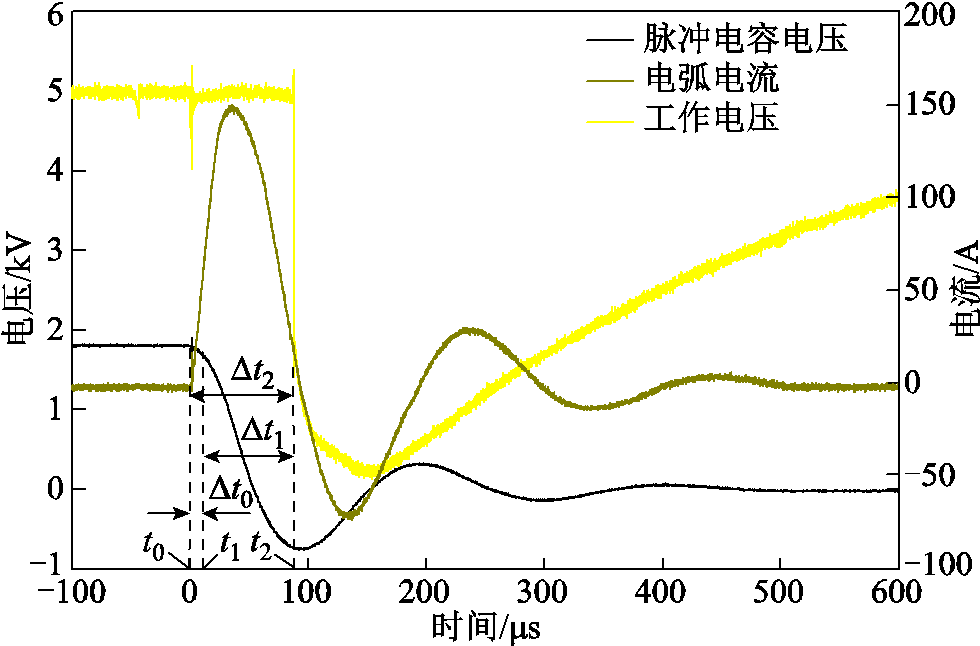
图2 气体间隙开关典型放电波形
Fig.2 Typical discharge waveforms of gas gap switch
随着触发放电次数的累加,气体开关触发腔放电通道烧蚀累积效应引起其触发性能逐渐劣化,制约了气体开关触发寿命。本节固定触发条件参数,开展气体间隙开关触发腔性能劣化进程中触通特征参数的变化规律研究。触发放电间隔3 min,且以任意十次中出现三次或连续两次以上触发失败作为触发寿命终止依据,并定义触发失效时的累计触发放电次数为其触发寿命。开关触通过程中等离子体喷射特性参数(喷射高度、喷射直径、喷射面积)变化如图3所示,触发放电时延(喷射时延、击穿时延和触通时延)变化如图4所示,触发腔表面形貌如图5所示,其烧蚀累积形貌特征量变化见表1。
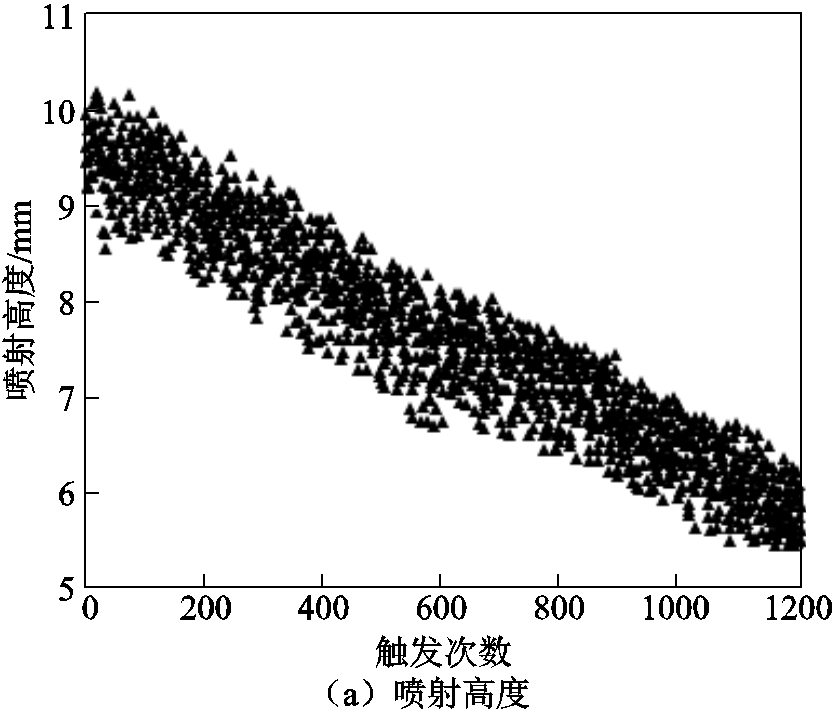

图3 等离子体喷射特征参数变化
Fig.3 Variation of plasma jet characteristic parameters with trigger times
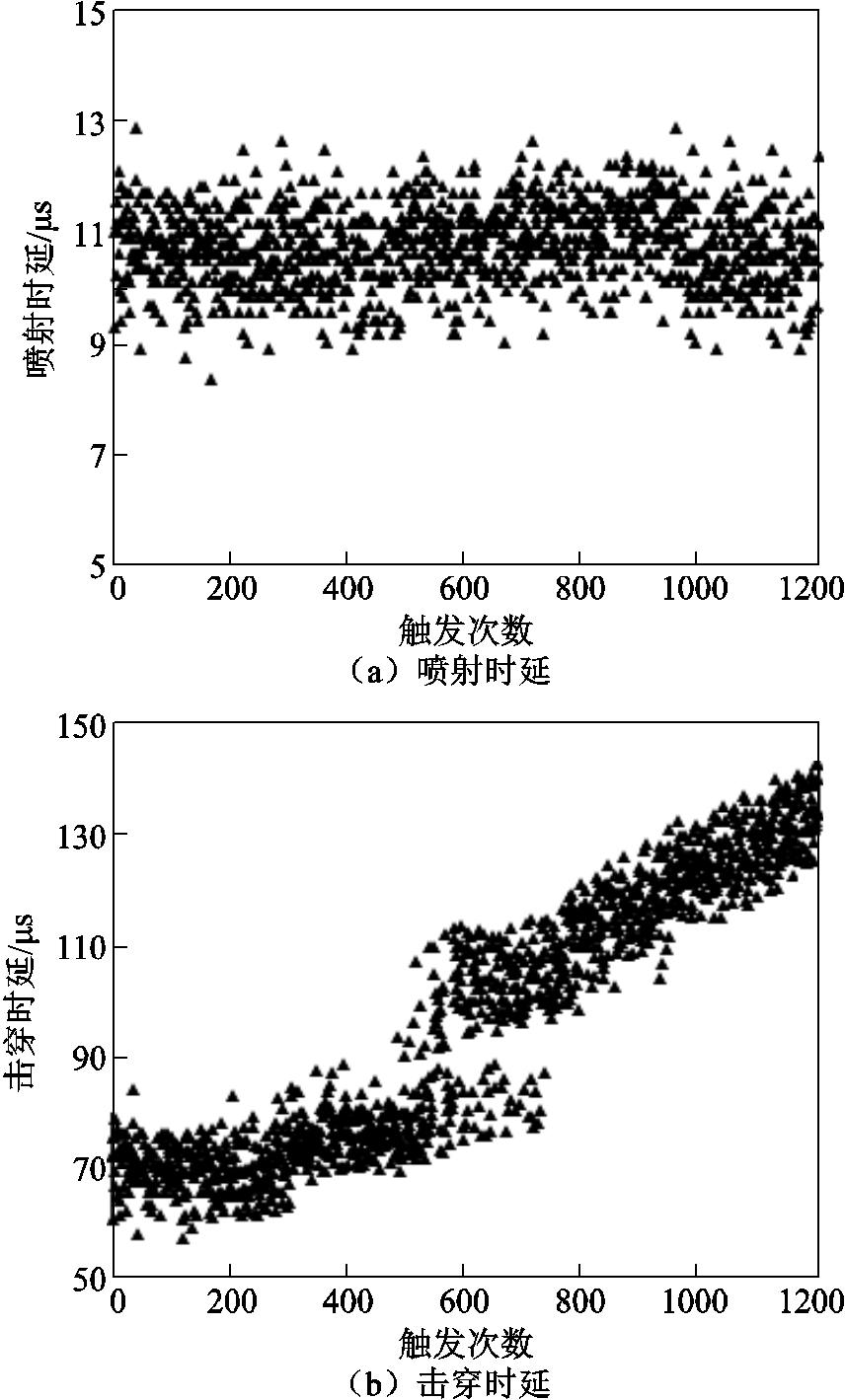
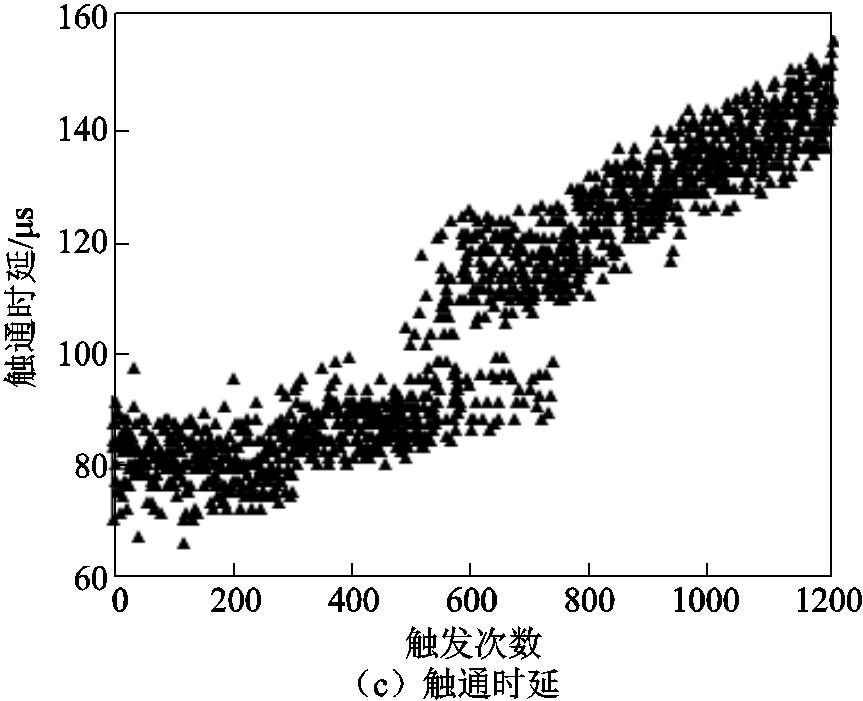
图4 气体间隙开关触发放电时延变化
Fig.4 Variation of discharge delay with trigger times

图5 触发腔表面形貌
Fig.5 Surface morphology of trigger cavity
表1 触发腔烧蚀累积形貌特征量
Tab.1 Morphology characteristics of the trigger cavity under cumulative ablation

参数数值 N=0N=500N=800N=1 200 ra/μm1.613.721.526.1 d1/mm22.192.372.45 d2/mm22.112.302.43 m/mg0378196
注:N为触发放电次数;ra为表面粗糙度;d1为针电极处毛细管内径;d2为喷口直径;m为烧蚀量。
分析图3~图5及表1可得:
1)随着触发放电次数的累加,等离子体喷射特性参数(喷射高度、喷射直径、喷射面积)均呈减小趋势。寿命初期,聚四氟乙烯在焦耳热的作用下发生相变后,由于C—C键能相对较小,会在温度720 K左右发生解离,生成小分子碳氟化合物气体,其解离产物中大部分为C2F4单体,具有极高的蒸气压,若从聚合物碳链上分离,会立刻脱离聚四氟乙烯表面,形成高密度气体层。这一过程没有特定的温度发生点及能量阈值,因而该现象在聚四氟乙烯发生相变后一直存在。而C2F4单体、SF6气体的电离能分别为11.96 eV、15.03 eV,即该气体层的存在为气体放电提供了良好的气体环境,电弧烧蚀产生的等离子体量更多,触发腔内的热膨胀效应更明显,喷口处的内外气压差较大,等离子体喷射特性参数最优。寿命末期,喷射高度低至5.5 mm,无法诱导开关主间隙击穿,气体间隙开关触发失效,触发寿命高达1 200次。
2)随着触发放电次数的累加,触发腔表面及内部放电通道有明显的黑色烧蚀产物附着,其内壁炭化产物累积引起表面粗糙度ra由1.6 μm增大至26.1 μm,使其绝缘材料产气能力降低,相同触发条件下产生的等离子体量减少;其次,触发腔针电极处毛细管内径d1、喷口直径d2分别从初始的2 mm、2 mm增大至1 200次时的2.45 mm、2.43 mm,引起喷口处内外气压差降低。综合作用下,触发腔内的热膨胀效应减弱,引起等离子体高速喷射的气动力大幅衰减,喷射速度减小,喷射高度降低,诱导主间隙击穿的作用逐步减弱。
3)随着开关触发腔性能的不断劣化,喷射时延在8.5~13.8 μs内波动,无明显增加;击穿时延、触通时延分别从寿命初期的68 μs、77 μs增大至末期的135 μs、150 μs,均增加约1倍,且当触发放电次数达到500~800时,二者的分散性均较大,波动区间高达30 μs。主要原因是:一方面,该阶段的d2和m因电弧烧蚀累积产生的增量分别达到0.19 mm和44 mg,较前500次的增量(0.11 mm和37 mg)明显上升;另一方面,触发腔内壁累积大量黑色烧蚀产物,影响其反射光学特性,抑制内壁表面及浅层材料对电弧辐射能的吸收,导致产气能力降低,喷射等离子体的总量大幅衰减。等离子体喷射高度由10.1 mm降低至7.7 mm,气体间隙开关触通过程中出现明显的预击穿效应[10],导致击穿时延和触通时延在触发放电500~800次时均有近似垂直上升的突变。
基于2.1节研究,本节采用高分辨场发射扫描电子显微镜(High Resolution Field Emission Scanning Electron Microscope, HR-FESEM)观测触发腔内壁微观形貌变化,如图6所示。气体开关触发失效时放电通道烧蚀累积产物的元素能谱如图7所示。不同触发放电次数下元素含量如图8a所示,其C、F原子数比如图8b所示。
分析图6~图8可得:触发性能劣化进程中,触发腔内壁针电极处的烧蚀孔洞由“点—线—面”发展。随着触发放电次数累加,烧蚀孔洞数量增多、半径逐渐增大并相互粘连,形成“线”状放电沟壑,直径为40.4 μm;在寿命末期粘连成“面”,抑制触发腔内的等离子体产生、积聚过程,气体开关触通性能降低,制约其触发寿命。喷口处无明显烧蚀孔洞,炭化产物不断累积形成大量凹坑、凸起,平均半径分别为19.3 μm、59.5 μm。

图6 触发腔内壁微观形貌变化
Fig.6 Micro-morphology changes of the inner wall in the trigger cavity

图7 触发放电通道烧蚀累积产物元素能谱
Fig.7 Elemental energy spectrum of ablation product in trigger discharge channel
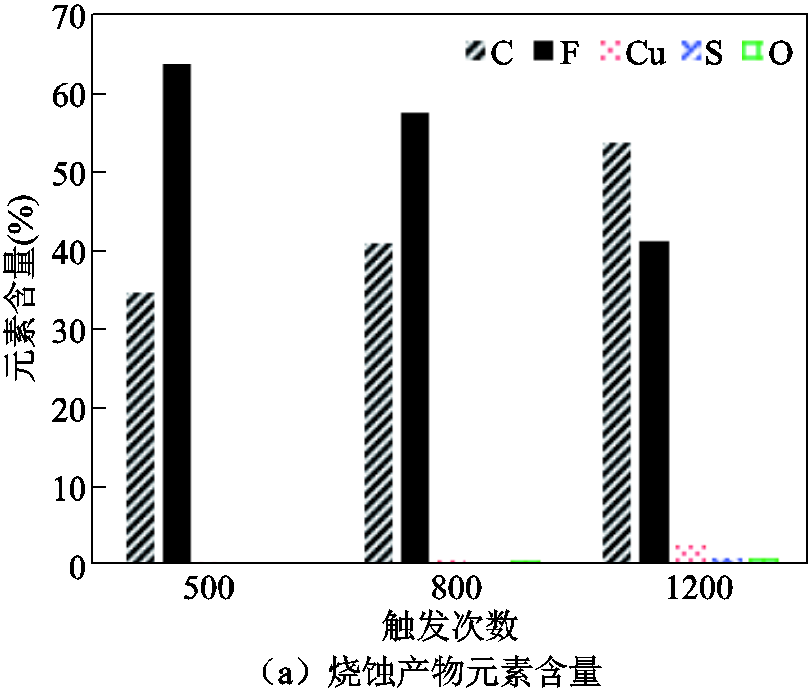
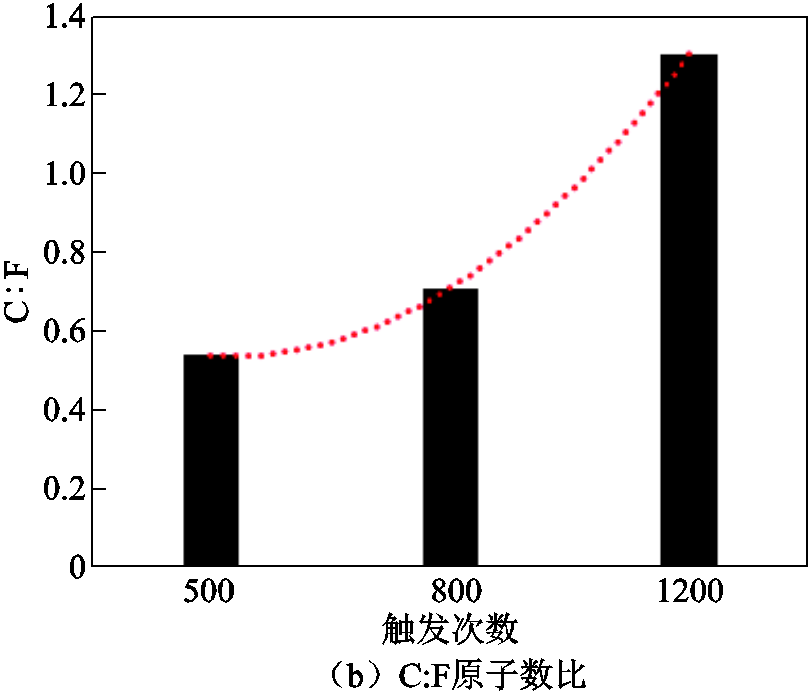
图8 触发放电通道烧蚀产物组分
Fig.8 Composition of ablation product in trigger discharge channel under different trigger times
分析原因主要为:在焦耳热的作用下,触发腔内壁表面和浅层绝缘材料在短时间内发生蠕变、流动甚至分解,容易液化飞溅或形成蒸气,降温后易凝结而附着在触发腔内壁,导致颜色明显变黑。聚四氟乙烯热传导性较差,使其会在μm量级的厚度上形成比较大的温度梯度,进而造成熔融工质产生大颗粒的喷溅,电弧烧蚀累积作用下,表面出现凹坑;同时烧蚀产物不断积累,易形成表面凸起;表面粗糙度逐渐增大,导致局部高温效应更加明显,凹坑半径及深度、凸起半径和高度不断增加。此外,触发腔绝缘材料历经熔融、凝固,在热胀冷缩效应下产生了很强的内应力,作用于烧蚀孔洞表面,从而形成贯穿性的劣化通道,导致气体间隙开关触发失败,制约其触发寿命。
此外,由聚四氟乙烯分子式(C2F4)n可知,C与F原子数比为1:2。触发放电1 200次后,触发腔放电通道表面烧蚀产物组分中C元素含量增加至53.64%,F元素含量减小至41.32%,即C与F的原子数比为1.3:1。因此,高温电弧烧蚀的累积作用使得聚四氟乙烯材料发生了剧烈的电热化学反应,分解产物主要有CF4、C2F4、C2F6、C3F6等强电负性气体[29-30]。在密闭小腔体SF6触发环境中,计及放电烧蚀产生分解产物的电负性效应,致其喷射等离子体发展过程受到明显抑制,显著制约了气体开关触发寿命。
由2.2节可知,表征气体开关触发腔性能劣化过程的特征参数随时间(触发放电次数)的变化规律具有明显的趋势性和序列相关性。因此,基于LSTM神经网络搭建气体开关剩余触发寿命预测模型,具体流程如图9所示。
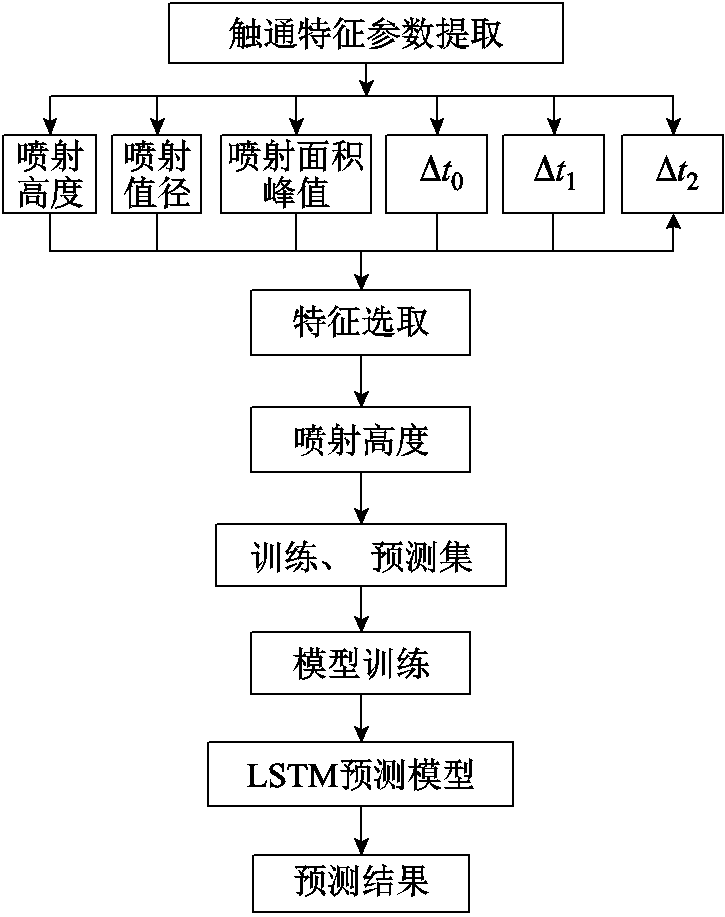
图9 气体开关剩余触发寿命预测流程
Fig.9 Flow chart of remaining trigger lifetime prediction
气体开关全寿命过程数据可提取出多个能够反映其触发状态的特征参数,如等离子体喷射特性参数(喷射高度、喷射直径及喷射面积峰值)、触发放电时延(Δt0, Δt1, Δt2)以及触发腔烧蚀量等特征参数。但较多的特征信息会含有大量冗余信息,增加了预测模型的复杂度[31]。因此,需对特征参数进行筛选并确定合适的预测因子。通过灰色关联分析法(Grey Relation Analysis, GRA)、皮尔逊相关系数法(Pearson Correlation Coefficient, PCC)对上述特征参数进行筛选,并输入LSTM 模型进行训练。
2.3.1 模型理论基础
1)灰色关联分析法
灰色关联分析[32]通过计算参考序列和比较序列数据的相似度,确定其相关程度。设参考序列为x={x(1), x(2),…, x(n)},第j个比较序列为yj={yj(1), yj(2),…, yj(n)},j=1, 2,…, n,则无量纲处理及关联系数计算过程为
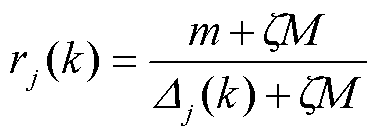 (2)
(2)
 (3)
(3)
其中



式中,z(k)为序列x或yj中的原始数据点,k=1, 2,…, n;z′(k)为经无量纲处理后的数据点;zmax、zmin分别为对应序列中的最大和最小数据点;rj(k)为参考序列与第j个比较序列的关联系数;Δj(k)为参考序列与第j个比较序列间的差序列;rj为关联度;M和m分别为差序列的最大值和最小值;ζ为分辨系数。
2)皮尔逊相关系数法
皮尔逊相关系数用于衡量变量间的相关程度,其值为−1~1,其关联度标准见表2。设两组特征参数分别为X={X1, X2,…, Xn},Y={Y1, Y2,…,Yn},其皮尔逊相关系数 计算过程为
计算过程为
 (4)
(4)
 (5)
(5)
 (6)
(6)
 (7)
(7)
 (8)
(8)
式中,E(X)和E(Y)分别为X和Y的平均值;Cov(X,Y)为两组参数间的协方差;σX和σY分别为X和Y的标准差。
表2 皮尔逊相关系数关联度标准
Tab.2 PCC correlation degree standard

相关性负正 无-0.1~00~0.1 弱-0.5~0.10.1~0.5 中-0.8~0.50.5~0.8 强-1.0~0.80.8~1.0
3)LSTM神经网络模型
LSTM是循环神经网络RNN的特殊变体,引入门结构(遗忘门、输入门、输出门),通过门单元的逻辑控制决定数据信息是否更新或丢弃,克服了RNN权重影响过大、容易产生梯度消失和爆炸的缺点,使网络可以更好、更快地收敛,其结构如图10所示。
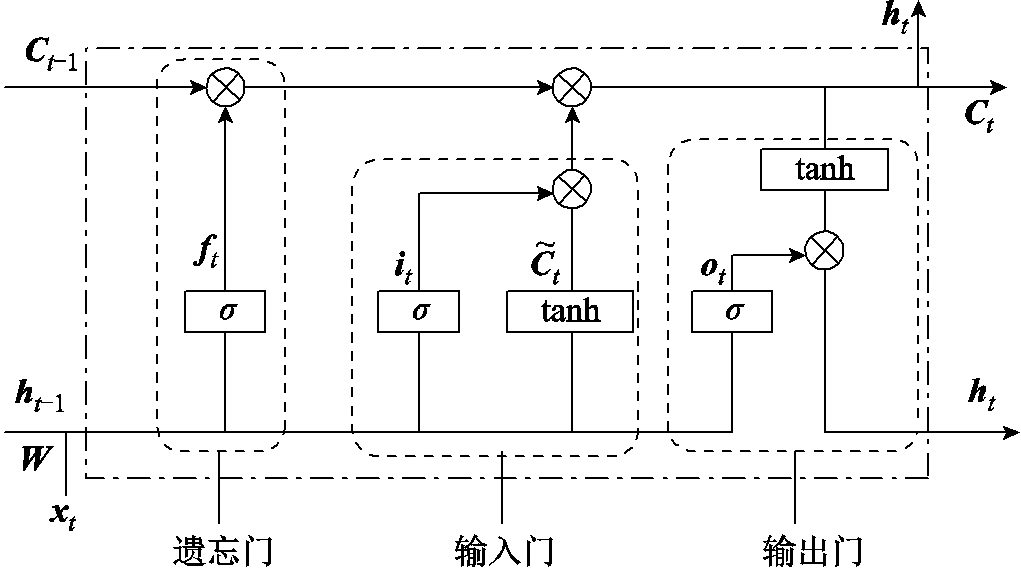
图10 LSTM结构
Fig.10 Internal structure of LSTM
LSTM数学模型为[33]
 (9)
(9)
 (10)
(10)
 (11)
(11)
 (12)
(12)
 (13)
(13)
 (14)
(14)
式中,f、i、o分别为遗忘门、输入门、输出门;t为当前时刻; 和C分别为待更新的神经元和当前神经元的状态;h为神经网络的输出;W*、U*、b*分别为对应门结构的当前时刻输入权重、上一时刻输出权重、输出的偏置;
和C分别为待更新的神经元和当前神经元的状态;h为神经网络的输出;W*、U*、b*分别为对应门结构的当前时刻输入权重、上一时刻输出权重、输出的偏置; 为sigmoid激活函数;
为sigmoid激活函数; 表示按对应元素相乘。
表示按对应元素相乘。
2.3.2 预测因子选取
设定参考序列为气体开关触发放电次数,比较序列为触通特征参数,通过灰色关联分析法计算各特征参数与触发放电次数(触发寿命)的相关度,如图11所示。图中,编号1~6分别为喷射高度、喷射面积、喷射直径、喷射时延、击穿时延和触通时延。分析图11可知,喷射时延与触发放电次数之间的相关度最小,即喷射时延对气体开关触发寿命的影响最小,故将其剔除。但灰色关联分析法忽略了各触通特征参数之间的相关性。
鉴于各触通特征参数均为连续变量且随着触发放电次数累加而呈变化态势,采用皮尔逊相关系数法计算各组特征参数之间的相关系数。触通特征各参量间的相关性分析热力图如图12所示。
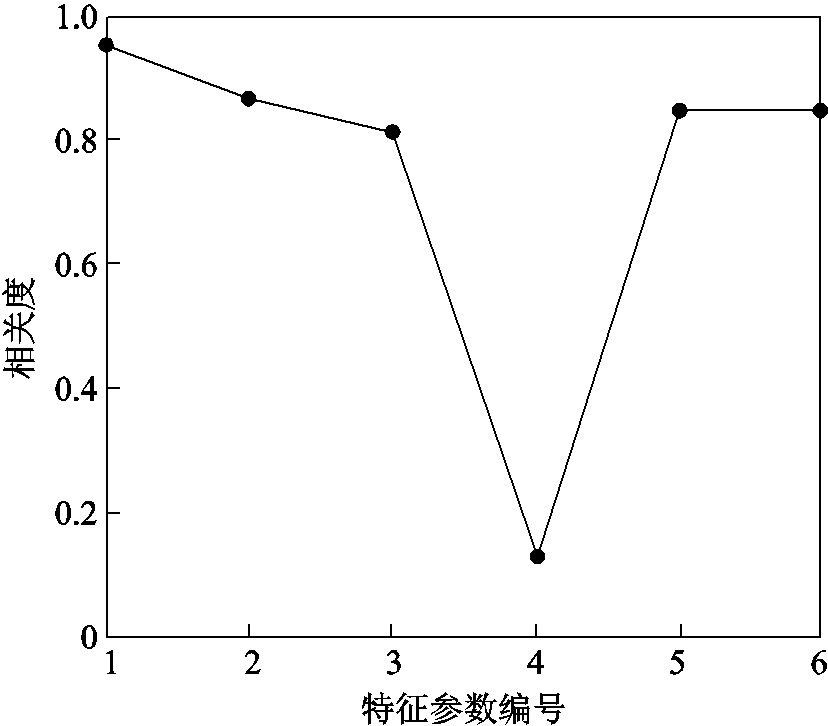
图11 GRA相关度
Fig.11 GRA correlation degree

图12 皮尔逊相关系数相关性分析热力图
Fig.12 PCC correlation analysis heat map
由图12和表2分析可知,各触通特征参数与触发放电次数间均存在一定的线性关系。相关系数大小为:喷射高度>喷射面积>击穿时延>触通时延>喷射直径,且喷射高度与触发放电次数的相关系数高达0.953,呈强相关性;而触通时延、击穿时延与触发放电次数、喷射高度、喷射直径、喷射面积的相关系数均小于0.8,相关性较差。故选取喷射高度作为预测因子,对气体开关剩余触发寿命预测开展进一步研究。
2.3.3 模型搭建与评估
气体间隙开关剩余触发寿命预测模型框架如图13所示,整体为LSTM循环神经网络续接全连接神经网络结构,输入为等离子体喷射高度试验值,单元数量即为所选择的时间步长,最后一个时间步的输出为全连接网络的输入。全连接网络能增强模型的非线性表达能力,提高模型预测的准确性,其输出为等离子体喷射高度预测值。
将等离子体喷射高度值沿时间(触发放电次数累加)方向排列,采用滑动时间窗口构造LSTM输入,如图14所示,将喷射高度数据序列划分成多个子序列,并引入序列之间的依赖性,从而更好地捕捉数据序列间的特征和规律,并减少过拟合的风险。
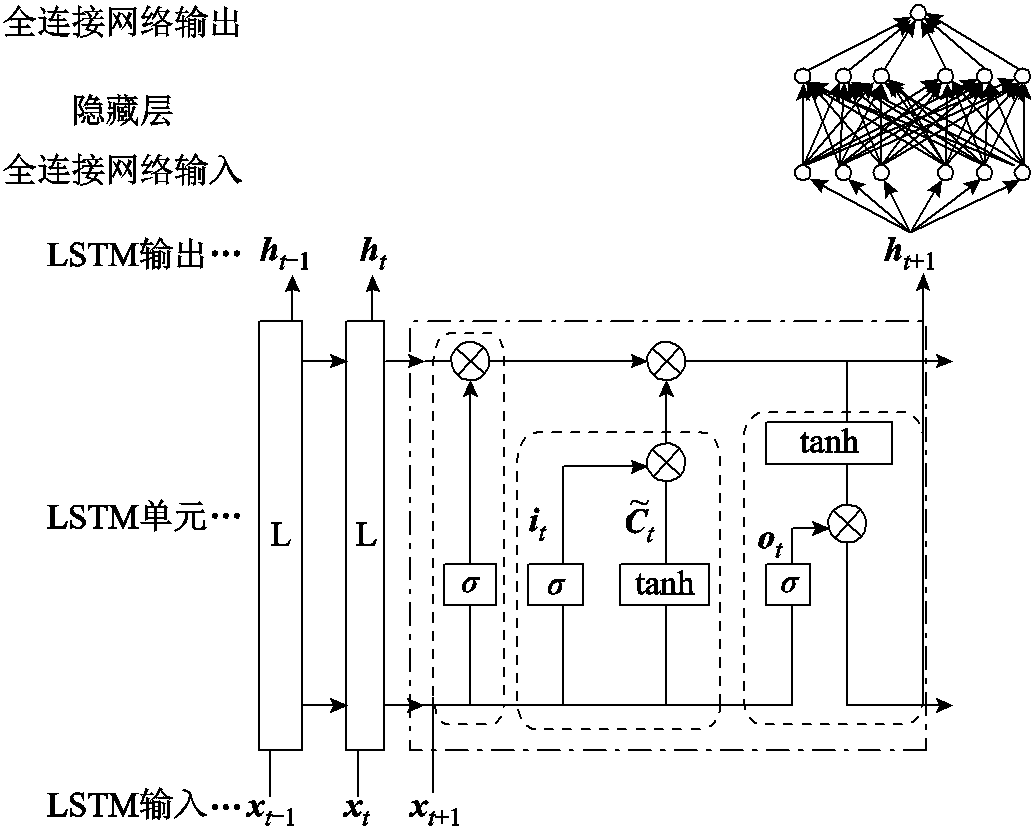
图13 气体间隙开关剩余触发寿命预测模型
Fig.13 Model of trigger lifetime prediction

图14 滑动时间窗构造输入样本数据
Fig.14 Constructs input sample data through sliding time window
此外,为防止过拟合现象,本文引入Dropout技术。Dropout技术由N. Srivastava等在2014年提出,是一种常用的防止过拟合技术[34-35],即在训练时以一定的比例随机使一些神经元失去活性,不会向前传递任何信息,应用Dropout技术的神经网络示意图如图15所示。
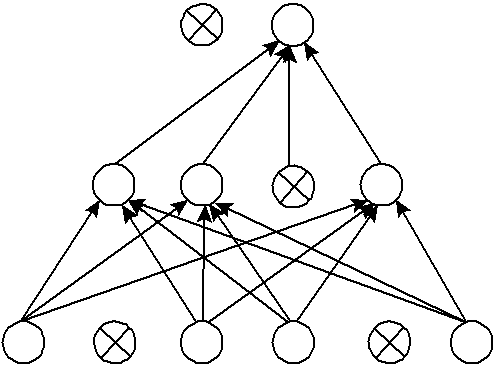
图15 应用Dropout技术的神经网络示意图
Fig.15 Neural networks using Dropout
模型中隐藏层的层数为1,通过调整隐藏层单元数量拟合复杂的非线性函数,一般由经验公式确定隐藏层单元数量范围[36],并进行多组不同的单元个数下的剩余触发寿命预测研究,对模型预测准确性进行对比分析。本文以方均根误差(Root Mean Squared Error, RMSE)、平均绝对百分比误差(Mean Absolute Percentage Error, MAPE)来检验模型预测值与真实值之间的误差,表达式分别为
 (15)
(15)
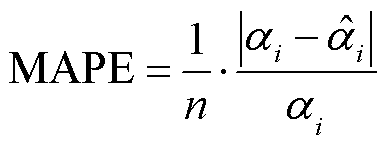 (16)
(16)
式中,n为预测循环次数; 为第i次触通特征参数试验值;
为第i次触通特征参数试验值; 为第i次触通特征参数预测值。
为第i次触通特征参数预测值。
2.3.4 预测结果分析
利用LSTM神经网络对气体间隙开关剩余触发寿命进行预测,将全寿命等离子体喷射高度划分数据集,其中以80%的数据为训练集,20%的数据为测试集。预测模型RMSE和MAPE变化特性如图16所示。
分析可知,随着时间步长、Dropout比例和隐藏层单元数的增大,RMSE和MAPE均呈U形变化,即先减小后增大的趋势。时间步长、Dropout比例和隐藏层单元数分别设置为12、0.3和50时,RMSE、MAPE分别低至0.063、0.055,即预测值与试验值之间的拟合度高,计算模型的预测精度满足气体开关剩余触发寿命预测要求。


图16 模型预测误差影响特性
Fig.16 Influence characteristics of prediction errors
由2.1节可知,当喷射高度低于5.5 mm时气体间隙开关触发失效,触发寿命终止,因此,本节以喷射高度小于5.5 mm作为触发寿命终止的临界条件。利用LSTM神经网络的寿命预测结果如图17所示,气体开关触发寿命预测结果为1 293次,与试验值的偏差在10%以内,可以满足气体开关触发寿命预测要求。

图17 剩余触发寿命预测
Fig.17 Trigger lifetime prediction
1)随着气体开关触发腔性能逐渐劣化,触发腔针电极处内径、喷口直径与内壁粗糙度均逐渐增大,喷口处出现烧蚀凹坑、凸起点,针电极处的烧蚀孔洞由“点—线—面”发展,引起气体开关触通过程中的等离子体喷射特性参数(喷射高度、喷射直径、喷射面积)均逐渐减小,触通时延、击穿时延均明显增大,气体开关寿命截止时的喷射高度减小45.5%,触通时延、击穿时延均增大1倍。在强绝缘、强电负性SF6触发环境中,计及放电烧蚀产生分解产物的电负性效应,喷射等离子体发展过程受到明显抑制,显著制约了触发寿命。
2)基于灰色关联分析法和皮尔逊相关系数法,筛选表征气体开关触发性能劣化过程的特征参数,选定喷射高度为模型预测因子,建立了基于LSTM的气体开关剩余触发寿命预测模型。其超参数(时间步长、Dropout比例、隐藏层单元数)对模型预测结果有较大影响,当时间步长为12、Dropout比例为0.3、隐藏层单元数为50时,模型预测值与试验值间的方均根误差和平均绝对百分比误差分别低至0.063、0.055,拟合度最优,此时气体开关剩余触发寿命预测结果与试验值的偏差在10%以内,可用于气体开关触发寿命预测。
参考文献
[1] 王建华, 张国钢, 耿英三, 等. 智能电器最新技术研究及应用发展前景[J]. 电工技术学报, 2015, 30(9): 1-11.
Wang Jianhua, Zhang Guogang, Geng Yingsan, et al. The latest technology research and application prospects of the intelligent electrical apparatus[J]. Transactions of China Electrotechnical Society, 2015, 30(9): 1-11.
[2] 唐巍, 张起铭, 张璐, 等. 新型配电系统多层级交直流互联理念、关键技术与发展方向[J]. 电力系统自动化, 2023, 47(6): 2-17.
Tang Wei, Zhang Qiming, Zhang Lu, et al. Concept, key technologies and development direction of multilevel AC/DC interconnection in new distribution system[J]. Automation of Electric Power Systems, 2023, 47(6): 2-17.
[3] 韩翔宇, 纽春萍, 何海龙, 等. 电磁式断路器状态监测与智能评估技术综述[J]. 电工技术学报, 2023, 38(8): 2191-2210.
Han Xiangyu, Niu Chunping, He Hailong, et al. Review of condition monitoring and intelligent assessment of electromagnetic circuit breaker[J]. Transactions of China Electrotechnical Society, 2023, 38(8): 2191-2210.
[4] 钟建英, 陈刚, 谭盛武, 等. 高压开关设备关键技术及发展趋势[J]. 高电压技术, 2021, 47(8): 2769-2782.
Zhong Jianying, Chen Gang, Tan Shengwu, et al. Key technology and development trend of high-voltage switchgear[J]. High Voltage Engineering, 2021, 47(8): 2769-2782.
[5] 杨欢, 蔡云旖, 屈子森, 等. 配电网柔性开关设备关键技术及其发展趋势[J]. 电力系统自动化, 2018, 42(7): 153-165.
Yang Huan, Cai Yunyi, Qu Zisen, et al. Key techniques and development trend of soft open point for distribution network[J]. Automation of Electric Power Systems, 2018, 42(7): 153-165.
[6] 薛士敏, 陈超超, 金毅, 等. 直流配电系统保护技术研究综述[J]. 中国电机工程学报, 2014, 34(19): 3114-3122.
Xue Shimin, Chen Chaochao, Jin Yi, et al. A research review of protection technology for DC distribution system[J]. Proceedings of the CSEE, 2014, 34(19): 3114-3122.
[7] Kanchi S, Shukla R, Sharma A. Plasma triggered spark gap switch for multiple switch synchronization[J]. The Review of Scientific Instruments, 2020, 91(10): 104704.
[8] Liu Shanhong, Liu Xuandong, Shen Xi, et al. Discharge characteristics of a dual-electrode gas switch triggered by ejected plasma in N2 and SF6[J]. IEEE Transactions on Plasma Science, 2017, 45(6): 969-974.
[9] 闫家启, 申赛康, 孙国祥, 等. 伪火花放电的物理机制与应用综述[J]. 电工技术学报, 2021, 36(11): 2408-2423.
Yan Jiaqi, Shen Saikang, Sun Guoxiang, et al. Review on physical mechanisms and applications of pseudospark discharge[J]. Transactions of China Electrotechnical Society, 2021, 36(11): 2408-2423.
[10] 董冰冰, 陈子建, 陈维江, 等. 配电网用灵活控制特快速开关方案及其触发导通特性[J]. 高电压技术, 2022, 48(5): 1808-1816.
Dong Bingbing, Chen Zijian, Chen Weijiang, et al. Scheme of flexible control very fast switch and its discharge characteristics for distribution network[J]. High Voltage Engineering, 2022, 48(5): 1808-1816.
[11] 温伟杰, 李鹏宇, 李斌, 等. 多端口机械式直流断路器的动作策略与参数优化[J]. 电力系统自动化, 2021, 45(11): 86-94.
Wen Weijie, Li Pengyu, Li Bin, et al. Operation strategy and parameter optimization of multi-port mechanical DC circuit breaker[J]. Automation of Electric Power Systems, 2021, 45(11): 86-94.
[12] 郭兴宇, 黄智慧, 梁德世, 等. 新型机电混合断路器及其电流转移过程分析[J]. 电工技术学报, 2022, 37(24): 6411-6419.
Guo Xingyu, Huang Zhihui, Liang Deshi, et al. Analysis on novel electro-mechanical hybrid circuit breaker and its current commutation process[J]. Transactions of China Electrotechnical Society, 2022, 37(24): 6411-6419.
[13] 李黎, 刘刚, 林福昌, 等. 石墨型高能气体开关的电极使用寿命分析[J]. 中国电机工程学报, 2011, 31(6): 109-115.
Li Li, Liu Gang, Lin Fuchang, et al. Analysis on electrode lifetime of high power graphite spark gap switch[J]. Proceedings of the CSEE, 2011, 31(6): 109-115.
[14] 郭良福, 李黎, 赖贵友, 等. 石墨型高能两电极气体开关[J]. 强激光与粒子束, 2010, 22(12): 3034-3038.
Guo Liangfu, Li Li, Lai Guiyou, et al. High power graphite two-electrode spark gap switch[J]. High Power Laser and Particle Beams, 2010, 22(12): 3034-3038.
[15] 曾晗, 林福昌, 蔡礼, 等. 石墨电极烧蚀机理及实验[J]. 电工技术学报, 2013, 28(1): 43-49, 86.
Zeng Han, Lin Fuchang, Cai Li, et al. Mechanism and experiment of graphite electrode erosion[J]. Transac-tions of China Electrotechnical Society, 2013, 28(1): 43-49, 86.
[16] 李黎, 蔡礼, 鲍超斌, 等. 触发管型气体开关导通时延的分析及估算[J]. 中国电机工程学报, 2012, 32(7): 174-180, 207.
Li Li, Cai Li, Bao Chaobin, et al. Analysis and estimation of breakdown delay of gas trigatron switches[J]. Proceedings of the CSEE, 2012, 32(7): 174-180, 207.
[17] 蔡礼, 蔡芸, 林福昌, 等. 触发型3电极开关导通时延分析与数值计算[J]. 高电压技术, 2013, 39(3): 727-732.
Cai Li, Cai Yun, Lin Fuchang, et al. Analysis and numerical calculation on breakdown time of three-electrode trigatron gap[J]. High Voltage Engineering, 2013, 39(3): 727-732.
[18] 王虎, 危瑾, 常家森, 等. 场畸变气体开关寿命预测[J]. 中国电机工程学报, 2011, 31(19): 153-159.
Wang Hu, Wei Jin, Chang Jiasen, et al. Lifetime prediction of field-distortion gas switch[J]. Pro-ceedings of the CSEE, 2011, 31(19): 153-159.
[19] 李兴文, 贾申利, 张博雅. 气体开关电弧物性参数计算及特性仿真研究与应用[J]. 高电压技术, 2020, 46(3): 757-771.
Li Xingwen, Jia Shenli, Zhang Boya. Research and application on physical farameters calculation and behavior simulation of gas switching arc[J]. High Voltage Engineering, 2020, 46(3): 757-771.
[20] 王萍, 弓清瑞, 张吉昂, 等. 一种基于数据驱动与经验模型组合的锂电池在线健康状态预测方法[J]. 电工技术学报, 2021, 36(24): 5201-5212.
Wang Ping, Gong Qingrui, Zhang Jiang, et al. An online state of health prediction method for lithium batteries based on combination of data-driven and empirical model[J]. Transactions of China Electro-technical Society, 2021, 36(24): 5201-5212.
[21] 杨胜杰, 罗冰洋, 王菁, 等. 基于容量增量曲线峰值区间特征参数的锂离子电池健康状态估算[J]. 电工技术学报, 2021, 36(11): 2277-2287.
Yang Shengjie, Luo Bingyang, Wang Jing, et al. State of health estimation for lithium-ion batteries based on peak region feature parameters of incremental capacity curve[J]. Transactions of China Electrotechnical Society, 2021, 36(11): 2277-2287.
[22] 孙丙香, 任鹏博, 陈育哲, 等. 锂离子电池在不同区间下的衰退影响因素分析及任意区间的老化趋势预测[J]. 电工技术学报, 2021, 36(3): 666-674.
Sun Bingxiang, Ren Pengbo, Chen Yuzhe, et al. Analysis of influencing factors of degradation under different interval stress and prediction of aging trend in any interval for lithium-ion battery[J]. Transactions of China Electrotechnical Society, 2021, 36(3): 666-674.
[23] 赵书涛, 徐晓会, 尹子会, 等. 基于深度学习断路器储能机构故障诊断方法研究[J]. 高压电器, 2022, 58(10): 25-32.
Zhao Shutao, Xu Xiaohui, Yin Zihui, et al. Research on fault diagnosis method of charging operating mechanism of circuit breaker based on deep learning[J]. High Voltage Apparatus, 2022, 58(10): 25-32.
[24] 谢庆, 张煊宇, 王春鑫, 等. 新一代人工智能技术在输变电设备状态评估中的应用现状及展望[J]. 高压电器, 2022, 58(11): 1-16.
Xie Qing, Zhang Xuanyu, Wang Chunxin, et al. Application status and prospect of the new generation artificial intelligence technology in the state evaluation of power transmission and transformation equipment[J]. High Voltage Apparatus, 2022, 58(11): 1-16.
[25] 董冰冰, 郭志远, 文韬, 等. 两级沿面触发型气体开关等离子体喷射过程与触发导通规律[J]. 高电压技术, 2022, 48(11): 4656-4666.
Dong Bingbing, Guo Zhiyuan, Wen Tao, et al. Development process of jet plasma of two-stage surface-triggered gas switch and its trigger conduction law[J]. High Voltage Engineering, 2022, 48(11): 4656-4666.
[26] Dong Bingbing, Guo Zhiyuan, Zhang Zelin, et al. Numerical simulation and experimental verification of plasma jet development in gas gap switch[J]. Plasma Science and Technology, 2023, 25(5): 055505.
[27] 董冰冰, 陶磊, 李志兵, 等. 机械式直流断路器换流支路用气体间隙开关方案及其诱导击穿特性[J]. 高电压技术, 2022, 48(12): 4863-4872.
Dong Bingbing, Tao Lei, Li Zhibing, et al. A gas gap switch scheme for commutation branch of DC circuit breakers and its induced breakdown characteristics[J]. High Voltage Engineering, 2022, 48(12): 4863-4872.
[28] Zhao Xiangen, He Junjia, Luo Bing, et al. Relaxation process of the discharge channel near the anode in long air gaps under positive impulse voltages[J]. Journal of Physics D: Applied Physics, 2017, 50(48): 485206.
[29] Yang Ren, Xu Mengyuan, Yan Jing, et al. Decomposition characteristics of SF6 under arc discharge and the effects of trace H2O, O2, and PTFE vapour on its by-products[J]. Energies, 2021, 14(2): 414.
[30] Xu Mengyuan, Yan Jing, Yang Minghao, et al. Theoretical study of the chemical reaction mechanisms and reaction rates of CFx + SFy (where x = 1-3 and y = 1-6) in SF6-polytetrafluoroethylene arc plasma[J]. Journal of Applied Physics, 2019, 126(19): 193304.
[31] Wang Dong, Miao Qiang, Kang Rui. Robust health evaluation of gearbox subject to tooth failure with wavelet decomposition[J]. Journal of Sound and Vibration, 2009, 324(3/4/5): 1141-1157.
[32] 周二彪, 孙阳, 谭捷, 等. 面向新能源消纳的电网互联通道规划[J]. 高电压技术, 2020, 46(8): 2933-2940.
Zhou Erbiao, Sun Yang, Tan Jie, et al. Network interconnection channel planning for new energy consumption[J]. High Voltage Engineering, 2020, 46(8): 2933-2940.
[33] Ren Lei, Dong Jiabao, Wang Xiaokang, et al. A data-driven auto-CNN-LSTM prediction model for lithium-ion battery remaining useful life[J]. IEEE Transactions on Industrial Informatics, 2021, 17(5): 3478-3487.
[34] Srivastava N, Hinton G E, Krizhevsky A, et al. Dropout: a simple way to prevent neural networks from overfitting[J]. Journal of Machine Learning Research, 2014, 15(1): 1929-1958.
[35] Saito K, Ushiku Y, Harada T, et al. Adversarial dropout regularization[C]//6th International Conference on Learning Representations, ICLR 2018, Vancouver, BC, Canada, 2018: 1-15.
[36] 刘树鑫, 高士珍, 刘洋, 等. 基于LSTM的交流接触器剩余寿命预测[J]. 高电压技术, 2022, 48(8): 3210-3220.
Liu Shuxin, Gao Shizhen, Liu Yang, et al. Residual life prediction of AC contactor based on long short-term memory[J]. High Voltage Engineering, 2022, 48(8): 3210-3220.
Abstract The mechanical and electrical performance of gas gap switch’ trigger cavity inevitably decreases caused by repeated trigger discharge, causing a serious problem of trigger failure. In order to achieve stable trigger conduction of the gas gap switch, the study of the degradation process of the gas switch trigger performance under repeated trigger discharge was carried out based on the trigger lifetime research platform, the trigger conduction parameters strongly correlated with the deterioration process of the gas switch trigger cavity performance were obtained. Ultimately, a trigger lifetime prediction model of gas gap switch based on long short term memory (LSTM) network was established to predict the remaining trigger lifetime.
From the experimental results, it can be concluded:
(1) At the early stage of trigger lifetime, the plasma jet height is up to 10.1 mm, leading to the excellent trigger conduction performance of gas gap switch, with breakdown delay and contact delay as low as 68 μs and 77 μs. Under the effect of intense ablation along the surface arc current, the inner diameter at pin electrode and the nozzle diameter of trigger cavity increases gradually, the pressure difference between the inside and outside of the trigger cavity nozzle decreases, leading to a decrease in the plasma jet characteristics parameters, weakening the distortion effect of the background electric field in the main gap, resulting in the increase of the breakdown delay Δt1 and trigger delay Δt2. Within 500~800 trigger discharge times, pre-breakdown effect occurs obviously during the trigger conduction process of gas gap switch, leading to the breakdown delay and trigger delay disperse notably with the fluctuation value up to 30 μs. At the end of trigger lifetime, the jet height is as low as 5.5 mm, which cannot meet the needs for stable trigger conduction of gas gap switch, causing the trigger failure of gas gap switch with a trigger lifetime of up to 1 200 times.
(2) Under repeated trigger discharge, the ablation holes appear on the inner wall of trigger cavity at pin electrode and develop from point and line to plane, the carbonization products on the inner wall of trigger cavity at nozzle accumulate to form the pits and bulges, suppressing the generation and accumulation process of plasma in the trigger cavity. Furthermore, after the accumulation effect of high temperature arc ablation, PTFE has undergone intense electrochemical reaction, and the decomposition products are mainly CF4, C2F4, C2F6, C3F6 and other strong electronegative gases. In SF6 trigger environment with a sealed cavity, taking into account the electronegative effect of decomposition products produced by discharge ablation, the development process of plasma jet is obviously inhibited and the trigger lifetime is restricted.
(3) Based on GRA and PCC, considering the correlation law between plasma jet characteristic parameters (jet height, jet diameter and jet area), trigger discharge delay (Δt0, Δt1, Δt2) and the trigger performance degradation of gas gap switch, the plasma jet height is used as the predictor. Firstly, the gas switch trigger lifetime prediction model based on LSTM was established. Dropout technology is introduced to the model to avoid the over-fitting caused by model complexity. Secondly, the original trigger conduction characteristic parameters are divided into multiple subsequences by sliding time window, and the dependence between sequences is introduced, so as to better capture the characteristics and laws in the data sequence. Finally, the Dropout ratio, the number of hidden layer units, and the time step were optimized to decrease RMSE and MAPE between the model predicted value and the experimental value, ensuring the prediction accuracy of model. The remaining trigger lifetime prediction error is within 10%, which can well meet the requirements of gas switch trigger lifetime prediction.
Keywords: Gas gap switch, plasma jet, repeated trigger discharge, ablation accumulation, lifetimes prediction, distribution network
DOI: 10.19595/j.cnki.1000-6753.tces.230663
中图分类号:TM470
中央高校基本科研业务费专项资金和国家自然科学基金(52107142)资助项目。
收稿日期 2023-05-15
改稿日期 2023-06-29
董冰冰 男,1987年生,博士(后),副研究员,研究方向为开关类设备及成套装置研制,复杂环境下输电线路外绝缘放电理论与试验。E-mail:bndong@126.com(通信作者)
陈子建 男,1996年生,硕士研究生,研究方向为脉冲功率等离子体技术。E-mail:laochen163czj@163.com
(编辑 李 冰)